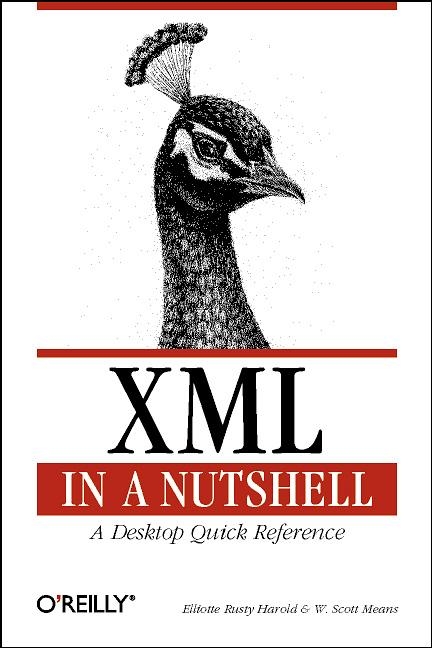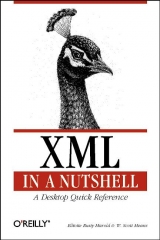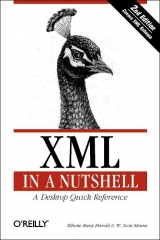XML in a Nutshell
O'Reilly Media (Verlag)
978-0-596-00058-5 (ISBN)
- Titel erscheint in neuer Auflage
- Artikel merken
XML, the Extensible Markup Language, is a W3C endorsed standard for document markup. Because of its ability to deliver portable data, XML is positioned to be a key Web application technology. Aiming to address the complexity and potential of this markup language, this text provides a desktop reference which should allow users to take advantage of XML's full potential. The book shows how to format files and data structures correctly for use in XML documents. XML defines a basic syntax used to mark up data with simple, human-readable tags, and provides a standard format for computer documents. This format is flexible enough to be customized for transforming data between applications as diverse as Web sites, electronic data interchange, voice mail systems, and wireless devices, to name a few. Developers can either write their own programs that interact with, massage, and manipulate the data in XML documents, or they can use off-the-shelf software like web browsers and text editors to work with XML documents. Either choice gives them access to a wide range of free libraries in a variety of languages that can read and write XML.
The XML specification defines the exact syntax this markup must follow: how elements are delimited by tags, what a tag looks like, what names are acceptable for elements, where attributes are placed, and so forth. XML doesn't have a fixed set of tags and elements that are supposed to work for everybody in all areas of interest for all time. It allows developers and writers to define the elements they need as they need them. Although XML is quite flexible in the elements it allows to be defined, it is quite strict in many other respects. This text covers the fundamental rules that all XML documents and authors must adhere to, detailing the grammar that specifies where tags may be placed, what they must look like, which element names are legal, how attributes attach to elements, and much more.
Elliotte Rusty Harold is a noted writer and programmer, both on and off the Internet. His Cafe au Lait website has become one of the most popular independent Java sites on the internet, and his spin-off site Cafe con Leche for XML News and Resources has become one of the most popular XML sites on the internet. Elliotte is the author of O'Reilly's Java Network Programming. W. Scott Means has been a professional software developer since 1988, when he joined Microsoft Corporation at the age of 17. He was one of the original developers of OS/2 1.1 and Windows NT, and did some of the early work on the Microsoft Network for the Advanced Technology and Business Development group. Most recently he is serving as the CEO of Industrial Web Machines, a new Internet venture based in Columbia, South Carolina.
Preface Part I. XML Concepts Chapter 1. Introducing XML What XML Offers Portable Data How XML Works The Evolution of XML Chapter 2. XML Fundamentals XML Documents and XML Files Elements, Tags, and Character Data Attributes XML Names Entity References CDATA Sections Comments Processing Instructions The XML Declaration Checking Documents for Well-Formedness Chapter 3. Document Type Definitions Validation Element Declarations Attribute Declarations General Entity Declarations External Parsed General Entities External Unparsed Entities and Notations Parameter Entities Conditional Inclusion Two DTD Examples Locating Standard DTDs Chapter 4. Namespaces The Need for Namespaces Namespace Syntax How Parsers Handle Namespaces Namespaces and DTDs Chapter 5. Internationalization The Encoding Declaration Text Declarations XML-Defined Character Sets Unicode ISO Character Sets Platform-Dependent Character Sets Converting Between Character Sets The Default Character Set for XML Documents Character References xml:lang Part II. Narrative-Centric Documents Chapter 6. XML as a Document Format SGML's Legacy Narrative Document Structures TEI DocBook Document Permanence Transformation and Presentation Chapter 7. XML on the Web XHTML Direct Display of XML in Browsers Authoring Compound Documents with Modular XHTML Prospects for Improved Web Search Methods Chapter 8. XSL Transformations An Example Input Document xsl:stylesheet and xsl:transform Stylesheet Processors Templates Calculating the Value of an Element with xsl:value-of Applying Templates with xsl:apply-templates The Built-in Template Rules Modes Attribute Value Templates XSLT and Namespaces Other XSLT Elements Chapter 9. XPath The Tree Structure of an XML Document Location Paths Compound Location Paths Predicates Unabbreviated Location Paths General XPath Expressions XPath Functions Chapter 10. XLinks Simple Links Link Behavior Link Semantics Extended Links Linkbases DTDs for XLinks Chapter 11. XPointers XPointers on URLs XPointers in Links Bare Names Child Sequences Points Ranges Chapter 12. Cascading Stylesheets (CSS) The Three Levels of CSS CSS Syntax Associating Stylesheets with XML Documents Selectors The Display Property Pixels, Points, Picas, and Other Units of Length Font Properties Text Properties Colors Chapter 13. XSL Formatting Objects (XSL-FO) XSL Formatting Objects The Structure of an XSL-FO Document Master Pages XSL-FO Properties Choosing Between CSS and XSL-FO Part III. Data-Centric Documents Chapter 14. XML as a Data Format Programming Applications of XML Describing Data Support for Programmers Chapter 15. Programming Models Event- Versus Object-Driven Models Programming Language Support Non-Standard Extensions Transformations Processing Instructions Links and References Notations What You Get Is Not What You Saw Chapter 16. Document Object Model (DOM) DOM Core DOM Strengths and Weaknesses Parsing a Document with DOM The Node Interface Specific Node Types The DOMImplementation Interface A Simple DOM Application Chapter 17. SAX The ContentHandler Interface SAX Features and Properties Part IV. Reference Chapter 18. XML 1.0 Reference How to Use This Reference Annotated Sample Documents Key to XML Syntax Well-Formedness Validity Global Syntax Structures DTD (Document Type Definition) Document Body XML Document Grammar Chapter 19. XPath Reference The XPath Data Model Datatype Location Paths Predicates XPath Functions Chapter 20. XSLT Reference The XSLT Namespace XSLT Elements XSLT Functions Chapter 21. DOM Reference Object Hierarchy Object Reference Chapter 22. SAX Reference The org.xml.sax Package The org.xml.sax.helpers Package SAX Features and Properties The org.xml.sax.ext Package Chapter 23. Character Sets Character Tables HTML4 Entity Sets Other Unicode Blocks Index
| Erscheint lt. Verlag | 8.2.2001 |
|---|---|
| Reihe/Serie | In a Nutshell S. |
| Zusatzinfo | index |
| Verlagsort | Sebastopol |
| Sprache | englisch |
| Maße | 153 x 229 mm |
| Gewicht | 660 g |
| Einbandart | kartoniert |
| Themenwelt | Mathematik / Informatik ► Informatik ► Web / Internet |
| ISBN-10 | 0-596-00058-8 / 0596000588 |
| ISBN-13 | 978-0-596-00058-5 / 9780596000585 |
| Zustand | Neuware |
| Haben Sie eine Frage zum Produkt? |
aus dem Bereich





